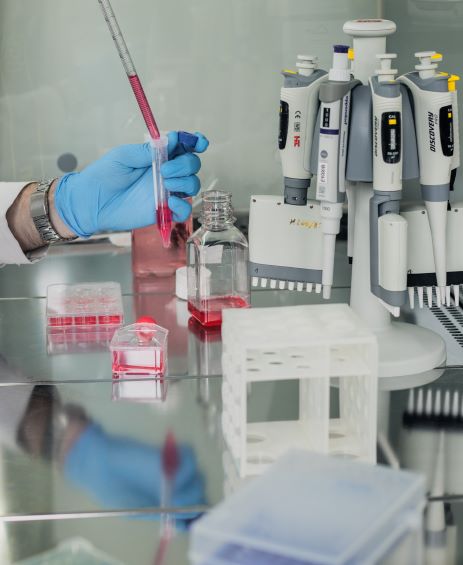
Phototoxicity testing
When summer time has already become just a memory, it is worth considering an issue that is often forgotten during sunny days. It is not always a good idea to combine certain medicines (but also other chemical substances) and the sun. Some of them can cause harmful effects on the skin when reacting with sunlight.
Skin phototoxicity (photoirritation) is defined as an acute toxic response caused by topically or systemically administered photoreactive chemicals after skin exposure to ambient light. The Łukasiewicz Research Network - Institute of Industrial Organic Chemistry Branch in Pszczyna rises this challenge that chemical manufacturers encounter on their way.
 We are now introducing our new study: in vitro phototoxicity - Reconstructed Human Epidermis Phototoxicity test method according to OECD 498. It is used to determine the phototoxic potential of a test chemical, e.g. a cosmetic, after topical application to laboratory-grown human epidermal tissues.
We are now introducing our new study: in vitro phototoxicity - Reconstructed Human Epidermis Phototoxicity test method according to OECD 498. It is used to determine the phototoxic potential of a test chemical, e.g. a cosmetic, after topical application to laboratory-grown human epidermal tissues.
You are welcome to contact us at: planowanie.pszczyna@ipo.lukasiewicz.gov.pl to get an offer.
Skin phototoxicity (photoirritation) is defined as an acute toxic response caused by topically or systemically administered photoreactive chemicals after skin exposure to ambient light. The Łukasiewicz Research Network - Institute of Industrial Organic Chemistry Branch in Pszczyna rises this challenge that chemical manufacturers encounter on their way.
 We are now introducing our new study: in vitro phototoxicity - Reconstructed Human Epidermis Phototoxicity test method according to OECD 498. It is used to determine the phototoxic potential of a test chemical, e.g. a cosmetic, after topical application to laboratory-grown human epidermal tissues.
We are now introducing our new study: in vitro phototoxicity - Reconstructed Human Epidermis Phototoxicity test method according to OECD 498. It is used to determine the phototoxic potential of a test chemical, e.g. a cosmetic, after topical application to laboratory-grown human epidermal tissues.You are welcome to contact us at: planowanie.pszczyna@ipo.lukasiewicz.gov.pl to get an offer.
Other news
- SETAC Europe 34th Annual Meeting
- Easter !
- Review of research work under the 2024 grant:
- SOT 63rd Annual Meeting and ToxExpo
- Phototoxicity testing
- New study for bees in offer
- On a way to trace ED!
- CPhI Worldwide 2023 Barcelona is coming
- Eurotox 2023 in Ljubljana is on
- Project subsidized
- EUROTOX 2023 Ljubljana
- New in vitro study available
- PCI Days 2023
- SETAC Dublin 2023 is on!
- SETAC Europe 33 Annual Meeting 2023 Dublin
- Technical employee needed
- Again FULL ACCREDITATION!
- .
- New alternative methods at Łukasiewicz - IPO
- Presentation of the results of research works financed by the ministerial subsidy
- POLECO 2022
- Jobb offers!
- Job offers
- Job offer
- Job offers
- Investment project NOBIAN
- Job offer- chemistry
- Job offer -HR
- Job offer for archivist
- Additional recrutation! Job offer - histopathologist, veterinarian
- NOBIAN
- Happy Easter!
- Job aplication
- Happy New Year 2021 !
- New web address
- .
- Łukasiewicz-rebranding of our Institute
- AAALAC International Accreditation
- Review of research studies conducted accoring to grant
- Merry Christmas and Happy New 2020 Year !
- .
- International Children’s Day
- Results of the competition for the position of the Deputy Head of the Branch for Administrative and Technical Issues
- Results of the competition for the position of the Deputy Head of the Branch for Research and Development
- R&D Project BioSafeFood
- R+D project BIOTECHNET
- Successful AAALAC accreditation
- New laboratories
Most important events
1947The Experimental-Research Station of Pesticides of the Azot Chemical Plant in Jaworzno and the Laboratory of Potato Beetle Biology and Control were founded in the place of the former School of Rural Household in Pszczyna.
1951The Experimental-Research Station of Pesticides was transferred to the Institute of Dyes and Semi-Manufactured Articles in Warsaw.
1957The Institute of Industrial Organic Chemistry in Pszczyna was founded as one of four branches of the main Institute of Industrial Organic Chemistry in Warsaw.
1960The following two research departments were founded:
- Department of Pesticide Biological Effectiveness Evaluation
- Department of Pesticide Side-Effects.


